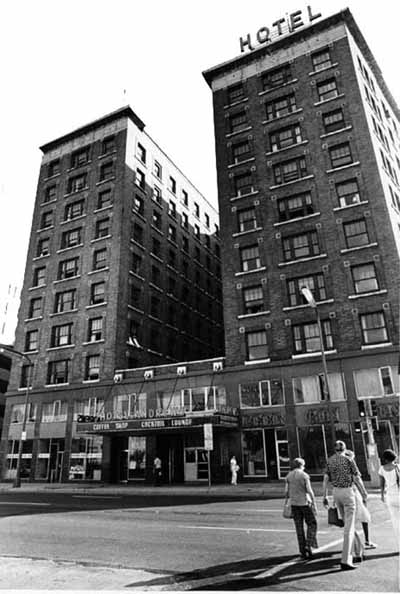Hotel Andrews
Southern Corner of Hennepin Avenue and Fourth Street South, Minneapolis (1960s-1984)
| A photograph of the Andrews around the time of the Kirpatrick murder. Courtesy of James Lileks. |
The Hotel Andrews was never as grand as The Nicollet Hotel, the Radisson, or other luxury hotels in Minneapolis, and it didn’t serve the same convention crowds that the Curtis and Leamington did further south.(1) Instead, the Andrews spent much of the 20th century’s first half as an affordable accommodation for visitors, traveling salesmen, and the assortment of people that one finds in suburban motels today.
|
On September 11th, 1976, Daniel Lee Moe and Father James Kirpatrick of Center, Texas went upstairs to the priest’s hotel room. The two got into a heated argument in the early morning hours, presumably after engaging in sexual activity, and the hustler stabbed Kirpatrick a dozen times with a knife. Police found the priest’s body and arrested Kirpatrick, who reportedly explained “He picked me up, man; he wanted sex, man; and he started stabbing me.”(4) The 17 year-old also exclaimed to a friend “Can you believe that a Reverend would attack me?”(5)
Male prostitutes were not the only queer men to use the space—for many years, the old bar room hosted a queer Haloween Party—but the newfound attention as a hustler’s hotel only added to its disrepute. By the 1980s, its fate became that of other Hennepin Avenue buildings; the City of Minneapolis demolished it by implosion in 1984, and it remains a surface-level parking lot.
(1) Millet, Larry. Twin Cities Then and Now. St. Paul: Minnesota Historical Society Press, 1996. Pages 56-57.
(2)Millet, page 288.
(3)"Demolition May Increase Homelessness." The Minneapolis Star-Tribune, 12/2/1986.
(4) “Priest’s Hustler Found Guilty.” Integrity, Vol. 3, issue 5: March, 1977.
(5) Ibid.
Part of Minneapolis/St. Paul, MN: 100 Queer Places in Minnesota History, (1860-1969), (1969-2010)
